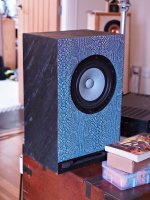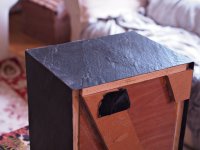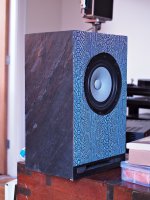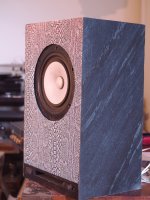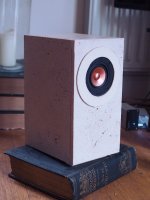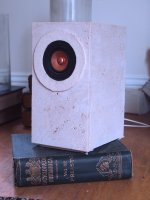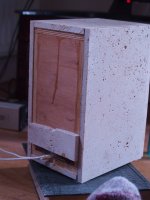Holy crap! Did you call a piano moving crew to get those set up?I did my speakers and amp in solid slate...
Last edited by a moderator:
Solid stone looks fantastic, but the difficulty of using it makes it impractical for most of us.
The stone veneer I'm thinking of using is this stuff: Natural Stone Veneer
Its a thin layer 1 or 2 mm (1mm = a 25th of an inch) resin bonded to a glass fibre backing. I'm thinking of using it instead of a traditional wood veneer, in the hope of producing something that looks like a slate enclosure, suppresses resonance perhaps better than a timber veneer, and will be less susceptible to movement due to changes in humidity etc., with the effect that can have on bending the panels or splitting the veneer.
I've just had a couple of samples delivered and it looks very promising, but i wondered if it had crossed anyone else's radar yet?
The stone veneer I'm thinking of using is this stuff: Natural Stone Veneer
Its a thin layer 1 or 2 mm (1mm = a 25th of an inch) resin bonded to a glass fibre backing. I'm thinking of using it instead of a traditional wood veneer, in the hope of producing something that looks like a slate enclosure, suppresses resonance perhaps better than a timber veneer, and will be less susceptible to movement due to changes in humidity etc., with the effect that can have on bending the panels or splitting the veneer.
I've just had a couple of samples delivered and it looks very promising, but i wondered if it had crossed anyone else's radar yet?
Just to add a little, the stiffness is less than the substrate (hardwood ply), and it will be attached with a PVA or similar glue. I don't anticipate any attachment / detachment problems. The idea is that two materials with differing characteristics will inhibit either from freely resonating in the way it would if left on its own. But I accept the idea may be wrong. Tell me if you think it might be.
The idea is that two materials with differing characteristics will inhibit either from freely resonating in the way it would if left on its own.
That would be what i would think.
Go for it and come back to us with how it worked. And pictures of course :^)
dave
Holy crap! Did you call a piano moving crew to get those set up?
Built them horizontally, had to call in my brother to get them upright... had back ache for 3 weeks after 🙂
Haven't weighed them but my guess is >100kg for the big ones.
Upside - I'm not worried about them being stolen 🙂
I guess somewhere there's a billiards/pool/snooker table with some big cutouts! 🙂
I asked the local stone worker for a quote, was > 1000 euros.
Then I just bought a cheap angle grinder with diamond blade (<100 euro), and a few huge slate floor tiles (around 60 euros) and cut it myself 🙂
Actually really easy to do, diamond blade goes through slate like it's butter.
Small ones used 100x50x1.5cm tiles, large ones I only remember the thickness which was 28mm.
All in all took me *way* less time than the normal sanding/painting routine with MDF!
Solid stone looks fantastic, but the difficulty of using it makes it impractical for most of us.
Read my post above, cutting the slate and gluing the leather took me way less time / effort than the normal sanding/painting of MDF.
Built them horizontally, had to call in my brother to get them upright... had back ache for 3 weeks after 🙂
Hopefully this will help anyone copying your design: when lifting bend your knees, not your back, never lift if you have a twist in your spine.
Or just build a temporary A-frame with a pulley system that gives you some mechanical advantage. $30 in material and you've got a one-man show.Hopefully this will help anyone copying your design: when lifting bend your knees, not your back, never lift if you have a twist in your spine.
Great idea, never even considered using floor tile for cabinet finishing.I asked the local stone worker for a quote, was > 1000 euros.
Then I just bought a cheap angle grinder with diamond blade (<100 euro), and a few huge slate floor tiles (around 60 euros) and cut it myself 🙂
Actually really easy to do, diamond blade goes through slate like it's butter.
Small ones used 100x50x1.5cm tiles, large ones I only remember the thickness which was 28mm.
All in all took me *way* less time than the normal sanding/painting routine with MDF!
Great idea, never even considered using floor tile for cabinet finishing.
Just make sure you've inspected the tile in person before ordering - I made a mistake with the big ones where the bottom of the tile wasn't cut straight but had grooves in it 🙂
(For a floor that doesn't matter - for an airtight speaker it's a bit of a challenge ;-))
I wonder, if I want to stay on the cheap side, 3 layers of walls - 2 layers of 1/4" MDF, then 1 layer of 1/4" oak board, all glued with PVA...
4 year late response!
Tried the thin stone veneer route as described a few posts back above, not sure about the accoustic benefit as I didn't play them without before applying the veneer, and anyway each MA A12pw would have needed running in first. I'm not that patient once started on a job.
I can say it is a good decorartive finish, they were a bit of an experiment, they have virtues, brilliant fast and articulate bass, but top end defenitely lacking something. That's not the cabinet but is almost certainly the A12pws, which are mid bass. Will be trying them active with a pair of MA7p and a pllxo soon.
Moving on, I'd completely endorse Pigmy's view, working stone tiles is easier than I thought til I tried, inspired by his posts here. I've built a pair of small Woden Bulldogs for the MA A5.3, in 12mm MDF first as a frame really, then covered with 12mm travertine (limestone) floor/wall tiles. Needed a special wet saw to cut them to size, but the result is v nice and I can detect no resonances whatsoever. They're in daily use, favourite small speakers so far. I'd recommend using stone tiles, they are a consistant thickness, readily available in UK up to 900mm, (mine came off Facebook Marketplace as left overs from someone's new bathroom), can be cut with the right equipement (my wet saw was only a cheap one for £50, a better one would make the job even easier and can be hired from most tool hire shops), and the cabinets are totally solid. Just don't drop one on your foot.
Floorstanding the weight might start to become prohibitive, though having seen the results I'm still tempted to give it a go.
pics to follow, though they're none of them as nice as the big slate and leather jobs.
Tried the thin stone veneer route as described a few posts back above, not sure about the accoustic benefit as I didn't play them without before applying the veneer, and anyway each MA A12pw would have needed running in first. I'm not that patient once started on a job.
I can say it is a good decorartive finish, they were a bit of an experiment, they have virtues, brilliant fast and articulate bass, but top end defenitely lacking something. That's not the cabinet but is almost certainly the A12pws, which are mid bass. Will be trying them active with a pair of MA7p and a pllxo soon.
Moving on, I'd completely endorse Pigmy's view, working stone tiles is easier than I thought til I tried, inspired by his posts here. I've built a pair of small Woden Bulldogs for the MA A5.3, in 12mm MDF first as a frame really, then covered with 12mm travertine (limestone) floor/wall tiles. Needed a special wet saw to cut them to size, but the result is v nice and I can detect no resonances whatsoever. They're in daily use, favourite small speakers so far. I'd recommend using stone tiles, they are a consistant thickness, readily available in UK up to 900mm, (mine came off Facebook Marketplace as left overs from someone's new bathroom), can be cut with the right equipement (my wet saw was only a cheap one for £50, a better one would make the job even easier and can be hired from most tool hire shops), and the cabinets are totally solid. Just don't drop one on your foot.
Floorstanding the weight might start to become prohibitive, though having seen the results I'm still tempted to give it a go.
pics to follow, though they're none of them as nice as the big slate and leather jobs.
Pictures as requested. Constructive criticism welcome. The ideas are often better (!! or possibly not) than execution. I've included the ugly back to one to show the random exterior anti resonance bracing.
The travertine tiles used on the MA 5.3 have the holes filled on one side, that's the side usually exposed in bathrooms etc., but I preferred the holey side. The felt circle was an anti diffraction something I'd read, whether it makes any difference is doubtful.
Driven at the moment by a Temple Audio Bantam Gold, lovely little class D made in Manchester.
The MA 12pw's were even more of an experiment. The box itself is far from ideal but it did demonstrate just how good a driver the A12pw is. I've some more to build boxes for next year.
Again the finishing could have been better, looking at them again to photograph drives this home. The slate veneer has a nice uneven surface. It can be a b****r to cut cleanly, but a sander takes off surplus fairly easily. Finish with a stone sealant, though a water based acrylic varnish would likely work as well. There are a number of different stone finishes available, red sandstone is tempting.
The baffle covering was another experiment. It is injet canvas printed with a snakeskin pattern and given multiple (5 or 6) coats of water based acrylic varnish, ends up a little like thinner vynyl flooring. Makes the eyes go funny in some shots, but paint can be boring after a while and the colour matched the cones, imo at least.
These had a surprising WAF, having got them down to take pictures they were described as "retro" and "quite nice", and are preferred to the FH-XL s in the background (I suspect because they're smaller though).
The travertine tiles used on the MA 5.3 have the holes filled on one side, that's the side usually exposed in bathrooms etc., but I preferred the holey side. The felt circle was an anti diffraction something I'd read, whether it makes any difference is doubtful.
Driven at the moment by a Temple Audio Bantam Gold, lovely little class D made in Manchester.
The MA 12pw's were even more of an experiment. The box itself is far from ideal but it did demonstrate just how good a driver the A12pw is. I've some more to build boxes for next year.
Again the finishing could have been better, looking at them again to photograph drives this home. The slate veneer has a nice uneven surface. It can be a b****r to cut cleanly, but a sander takes off surplus fairly easily. Finish with a stone sealant, though a water based acrylic varnish would likely work as well. There are a number of different stone finishes available, red sandstone is tempting.
The baffle covering was another experiment. It is injet canvas printed with a snakeskin pattern and given multiple (5 or 6) coats of water based acrylic varnish, ends up a little like thinner vynyl flooring. Makes the eyes go funny in some shots, but paint can be boring after a while and the colour matched the cones, imo at least.
These had a surprising WAF, having got them down to take pictures they were described as "retro" and "quite nice", and are preferred to the FH-XL s in the background (I suspect because they're smaller though).
Attachments
Last edited:
That's artificial felt, the natural one has a different appearance. Pic to follow.The felt circle was an anti diffraction something I'd read, whether it makes any difference is doubtful.
Last edited by a moderator:
I like them.
I have one of the original littleTemple Audio in my breifcase system (w µMar-Ken6m), a Haliburton briefcase i picked up at a thrift shop for $4. The temple ampcame from Sott’s closet — he has the biggermonoBloks.
Dave
Temple Audio Bantam Gold
I have one of the original littleTemple Audio in my breifcase system (w µMar-Ken6m), a Haliburton briefcase i picked up at a thrift shop for $4. The temple ampcame from Sott’s closet — he has the biggermonoBloks.
Dave
the natural one has a different appearance
And performance, natural felts tend to work better. Wool, cotton the most common.
dave
- Home
- Design & Build
- Construction Tips
- Discussion on what materials to build speakers out of
